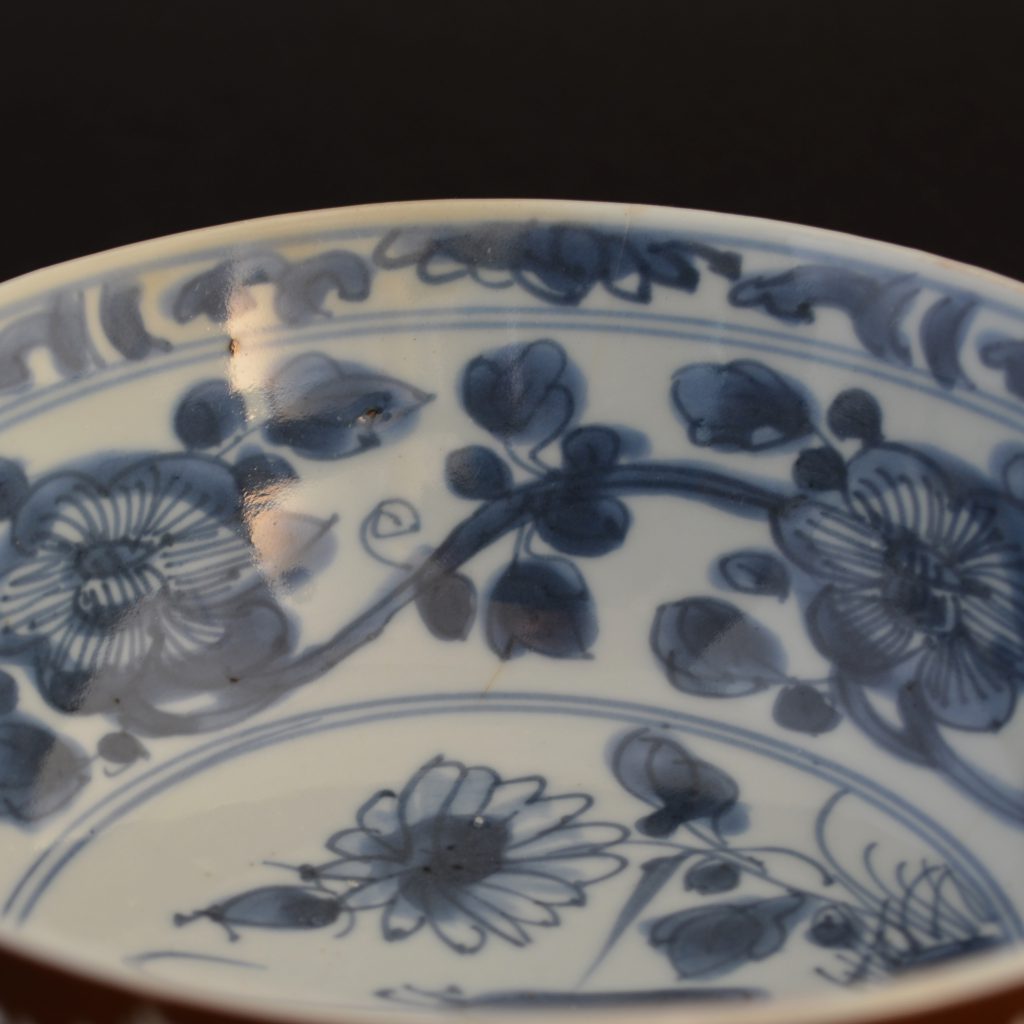
Kangxi c.1700-1720. ‘Batavia’ Ware Porcelain Bowl with Engraved European Decoration.
A late Kangxi porcelain bowl c.1700-1720. The interior of this ‘Batavia’ Kangxi bowl is decorated in a poor quality cobalt. The exterior has a rich brown ground (Batavia ware) which has wheel engraved decoration of stylised flowering foliage. The engraved decoration was executed in one of three places, Dresden, Bohemia and Silesia.
SOLD
- Condition
- There are three large but not obvious cracks and a deep v-shaped chip to the outer rim c.5 x 4 mamas well as a tiny shallow chip c.3 x 2 mm.
- Size
- Diameter : 15.5 cm (6 inches)
- Provenance
- N/A
- Stock number
- 24498
- References
- For teabowls and saucers with this type of wheel-engraving see : European Decoration on Oriental Porcelain 1700 - 1830 (Helen Espir,Jorge Welsh Books, 2005) Page 59, Item 12. Helen Espir`s notes about this teabowl and saucer ; "Fig.12 shows two Batavian cups and saucers; on the right wheel engraved with a rare hunting scene..". Wheel engraving was one of a number of techniques employed by Europeans to enliven Chinese porcelain. It is not often encountered. It is essentially a German glass decorating technique that was suited to the glaze of Chinese porcelain. By cutting deeply, the skilled engraver was able to remove the glaze completely, exposing the brilliant white porcelain, this contrasted well with the rich brown of the Batavia ware or other coloured glazes found on Chinese porcelain. Wheel engraving was practised at Dresden, Bohemia and Silesia in the 17th and 18th centuries." For more information about this technique see : European Decoration on European Porcelain 1700 - 1830 (Helen Espir,Jorge Welsh Books, 2005). For other Chinese export porcelain teabowls and saucers with wheel engraving see our `Sold Items` 17966, 17967, 20809, 22752, and a saucer shaped dish 23639.
Information
Batavia Ware :
Iron-oxide is possibly the most important colouring agent for glazes and it has been used in many ways over thousands of years to decorate Chinese ceramics. By controlling oxygen levels in the kiln as well as the amount of iron used in the glaze, a large variety of colours can be achieved. High concentrations of iron-oxide, around 5%, were used to colour the glaze to the deep rich brown that has become known as Batavia Ware, named after the V.O.C. trans-shipping town, rather than where the porcelain was made. The colour was added in the form of iron filings, occasionally one or two of them can be seen in the glaze. A Lesser amounts of iron-oxide would give the paler glaze colour known as Cafe au Lait. Both these glazes were used in conjunction with Blue and White, Famille Verte, Famille Rose as well as Imari decoration and were used on Chinese export ware during the 18th century.
Wheel-Engraving on Chinese Export Porcelain :
Wheel-engraving was one of a number of techniques employed by Europeans to enliven Chinese porcelain. It is not often encountered. It is essentially a German glass decorating technique that was suited to the glaze of Chinese porcelain. By cutting deeply, the skilled engraver was able to remove the glaze completely, exposing the brilliant white porcelain, this contrasted well with the rich brown of the Batavia ware or other coloured glazes found on Chinese porcelain. Wheel engraving was practiced at Dresden, Bohemia and Silesia in the 17th and 18th centuries. For similar teabowls and saucers with this type of decoration see : European Decoration on European Porcelain 1700 - 1830 (Helen Espir,Jorge Welsh Books, 2005) Page 59, Item 12. Helen Espir`s notes about this teabowl and saucer ; "Fig.12 shows two Batavian cups and saucers; on the right wheel engraved with a rare hunting scene..". A Teabowl and saucer with this type of decoration is on display in the Victoria and Albert Museum in London reference V&A : 306 & A-1895. It is published in : Chinese Export Ceramics (Rose Kerr, Luisa Mengoni, Ming Wilson, V&A Publishing 2011. ISBN 9781-85177-6320) page 97, plate 137.




